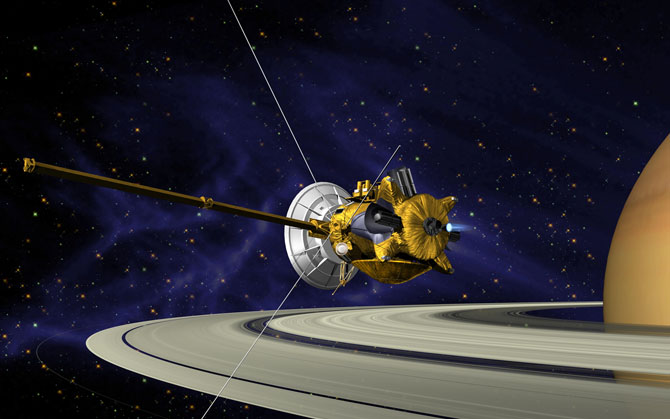Cassini-Huygens

6 August 2018
The Cassini mission to Saturn and its complex planetary environment consists of two spacecraft: the Cassini orbiter built by NASA with contributions from the Italian space agency, and the Huygens lander built by ESA which was the first probe to land on the moon of another planet. Cassini-Huygens was launched on 6 October 1997 and entered orbit around Saturn in June 2004. Huygens landed on Saturn's largest moon Titan, on 14 December 2005 returning fantastic images from the surface and making measurements of its thick atmosphere during its descent.
Science goals
The primary goal of Cassini-Huygens is to carry out an in-depth exploration and study of the saturnian system. Major areas of study for Cassini-Huygens are:
- Titan: the second largest moon in the Solar System and the thickest atmosphere of any moon.
- Magnetosphere: study Saturn's magnetic and plasma environment and determine how it interacts with the planet, rings, satellites and the Sun.
- Icy satellites: explore the icy satellites looking at how such small icy bodies have formed and evolved.
- Ring system: Saturn's rings are the best-developed ring system in the Solar System and Cassini will reveal this ring system in unprecedented detail.
- Saturn as a planet: Jupiter and Saturn are examples of giant planets which are found throughout the Milky Way. Cassini will explore Saturn as a planet and study its interior, atmosphere, magnetic field and origins.
The spacecraft
Cassini is the largest interplanetary spacecraft every built by NASA, standing 6.8 m tall with a main communications antenna that is 4 m in diameter. When it was launched Cassini weighed 5600 kg and over half of that launch mass was fuel.
Instruments
The Cassini orbiter carries a comprehensive suite of instruments:
- Cassini Plasma Spectrometer (CAPS).
- Composite Infrared Spectrometer (CIRS).
- Cassini Radar (RADAR).
- Radio Frequency Instrument Subsystem (RFIS).
- Magnetometer (MAG).
- Imaging Science Subsystem (ISS).
- Visible and Infrared Mapping Spectrometer (VIMS)
- Radio and Plasma Wave Science (RPWS)
- Ion and Neutral Mass Spectrometer (INMS)
- Magnetospheric Imaging Instrument (MIMI)
- Cosmic Dust Analyzer (CDA)
- Ultraviolet Imaging Spectrograph (UVIS)
The Huygens probe carried the folllowing set of instruments:
- Aerosol Collector and Pyrolyzer (ACP)
- Descent Imager and Spectral Radiometer (DISR)
- Doppler Wind Experiment (DWE)
- Gas Chromatograph/Mass Spectrometer (GCMS)
- Huygens Atmospheric Structure Instrument (HASI)
- Surface Science Package (SSP)
 Close
Close

